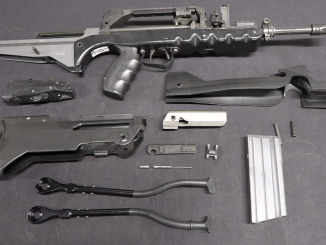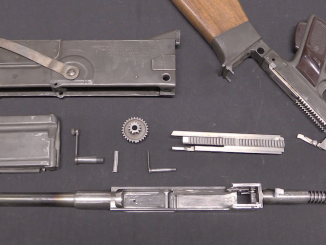Unlike Great Britain and Germany, the French military never developed a formal sniper doctrine during World War One – they had no dedicated schools or instruction manuals for that specialty. The three major arsenals did produce scoped sniping rifles, however, with models of 1915, 1916, and 1917 (and a post-war 1921 pattern). We have a model 1916 example here today.
The rifles were completely ordinary off-the-rack Lebels, modified simply to add scope mounts. The 1916 pattern mount used a round peg on the side of the rear sight and a bracket wrapped around the front of the receiver, which allowed the scope to be quickly and easily detached for carry in a separate pouch (similar to what other nations did, to protect the optic from damage when not in use). The rifles were issued only in small numbers (2 per company, or even 2 per battalion) and it was left to the unit commander to decide how to employ them.
This particular scope has some neat provenance of being brought home by a US soldier after the war – it came back wrapped in a period copy of Stars and Stripes magazine. The rifle is of the appropriate type, but the “N” marks on the barrel and receiver indicated French overhaul in the 1930s, precluding it from being the original rifle this scope was mounted on.




Clever and simple arrangement. I am also noticing that base materiel for optical tube, as was customary of the time, is brass. Apparently it was not that easy to mask it.
Thanks in part to Ian’s introductions I have fair bit of appreciation for French military technology of WW1 and after. Thanks for showing it.
Camouflage over the scope would require plenty of thought. And a sunshade tube would help with keeping the scope glint nonexistent. Too bad nobody thought of getting a squad marksman into the overall plan, as the doctrine of the day was having every infantryman do “one shot, one kill.” Nobody can do that under bombardment or machine gun fire…
Generally speaking, the main “one shot, one kill” weapon in an infantry CO’s possession was the telephone line back to HQ. Because the “one shot” would be delivered by a 155mm howitzer. That is, unless he had a 3-inch Stokes mortar team handy.
cheers
eon
“nobody thought of getting a squad marksman into the overall plan”
Still better than British issue of sniper shield incompatible with scoped rifles.
“as the doctrine of the day was having every infantryman do “one shot, one kill.””
I am not sure about that.
In 1914 French forces deployed Attaque à outrance tactic, soon to found it ineffective. Although they abandoned it, French commanders still were believing in usage of mass of infantry, for example General Nivelle used it to disappointment of men under his command.
https://www.youtube.com/watch?v=iwrc8yV6MJ8
Here’s a similar mount you can buy, when I had a lebel I thought about getting one: http://aassniper98.com/en/france/5343-montage-de-lunette-fusil-lebel-.html
The attachment style is similar, with the ring around the receiver in the front and a mounting point using the screw for the magazine cutoff.
When it was rechambered wouldn’t they have updated the scope mount to the latest spec? Or are those reproduction mounts added to an imported Lebel to be able to mount that scope? Or were the older style mounts left on the arsenal rechambered rifles to accommodate older style scopes still in inventory? It would seem that have multiple mount styles and scopes styles would be logistically difficult.
Dear Mr. Ian:
My name is Jorge Ivan, I write to you from Spain, and first of all I must congratulate you for your magnificent work, which I arrived a few days ago.
I have been seeing a rifle of French origin of 8 mm lebel type, for a few weeks, with the trench calls, for the “hump” that they have under the guard, which is a real jewel, I think modestly, that must be Attempts to manufacture a semiautomatic rifle. It has punches of the powder of ST.Chemon, celebrated for its campaign cannon, and the number 22 in each and every one of its pieces. The mechanism and the cajeado of the wood, are authentic works of art. It is disassembled in its entirety by operating a lever hidden in the disproportionate bolt, and achieves semiautomaticism achieved by actuating another lever located in the trigger guard. The cartridges are fed through an existing box in the stock, with a pulling system that carries the cartridges from the stock to the bedroom.
I have read everything that has fallen into my hands about it and I have not been able to identify it, it could help me identify it.
How could I send you a photograph?
Thank you for your attention, goodbye cordially
Jorge I. Fdez.
We have inherited an original Lebel 1914 WW1 French infantry rifle.
Simply looking ( as someone who does not know anything about antique rifles) If anyone out there who knows anything pertaining to this type of particular rifle. INFO INTERESTED IN LEARNING 1. How many made? 2. How many are known to still exist? 3.Current Price range ( if looking to sell or insure) Really any history info would be GREATLY APPRECIATED!!!! Thank You so Much!!!! ( FINGERS CROSSED)
This is Gerard….. just read my post and realized I forgot to put in the most important part…. ” AS SOMEONE WHO DOES NOT KNOW ANYTHING PERTAINING TO THIS TYPE OF ANTIQUE RIFLE….. THIS RIFLE LOOKS IN FANTASTIC CONDITION AND HAS ALSO BEEN TOLD THAT EXACT THING SEVERAL TIMES”